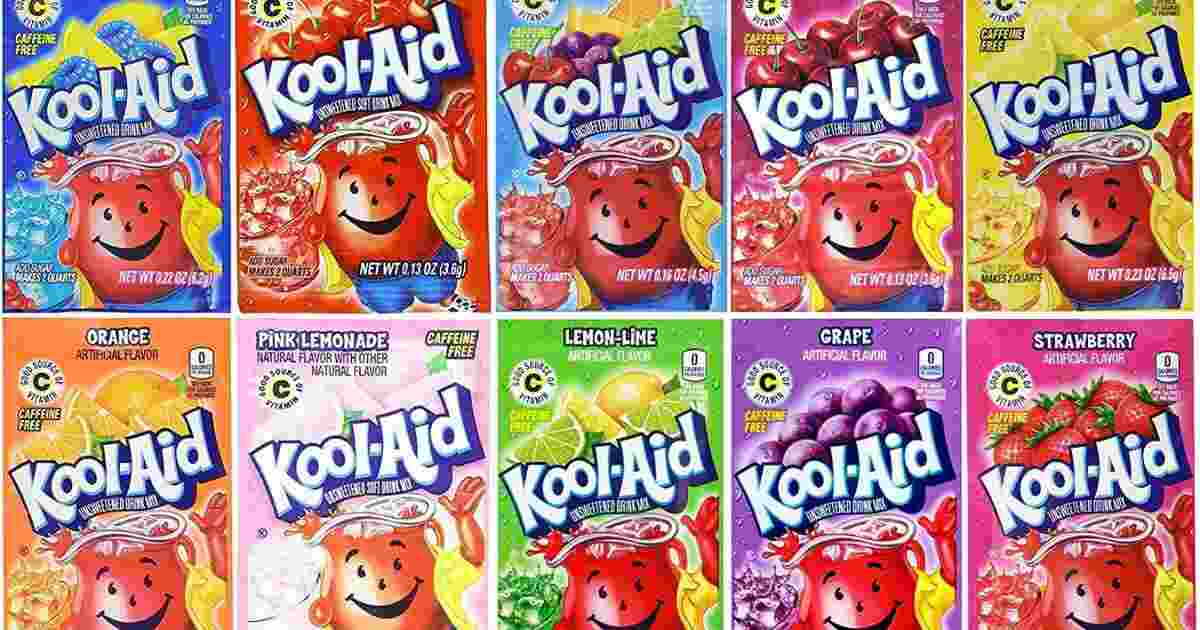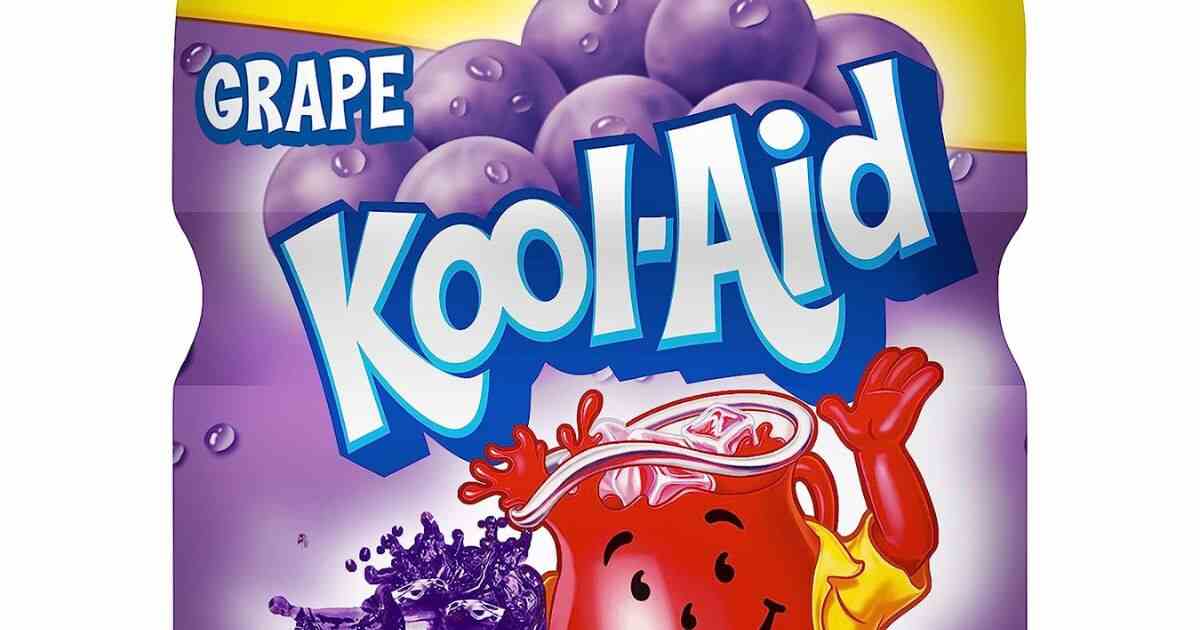Kool-aid contains 25 calories, 0g total fat, 5mg sodium, 0g of protein, and 6g of sugar per 1/8 packet (6.7 g). Kool-aid is a popular drink mix that has been around for generations.
It comes in a variety of flavors such as cherry, grape, and tropical punch. Kool-aid can be enjoyed by both kids and adults alike, and is a favorite summertime drink. It is also low in calories, containing only 25 calories per serving, making it a guilt-free refreshment.
In this article, we will take a closer look at the nutritional value of kool-aid and its ingredients. So, if you are a kool-aid fan, keep reading to find out more about this iconic drink.

Credit: www.everydayhealth.com
The Surprising Kool-Aid Nutrition Facts
Highlight The Hidden Sugar Content In Kool Aid
Kool aid is a refreshing drink that is loved by both kids and adults alike. But do you know how much sugar is present in your favorite kool aid? Well, the answer to that might surprise you. Here are some hidden facts about the sugar content in kool aid:
- A 20-ounce bottle of kool aid contains about 48 grams of sugar.
- This amount of sugar is equivalent to consuming 12 teaspoons of sugar, which is more than the recommended daily intake for both kids and adults.
- The sugar content in kool aid can lead to several health issues such as obesity, diabetes, and tooth decay.
Avoiding kool aid altogether might be difficult, but you can always limit its intake. You can try adding more water and less sugar to your kool aid, or you can opt for sugar-free alternatives.
Explain The Various Preservatives And Chemicals Present In Kool Aid
Kool aid contains several preservatives and chemicals that help prolong its shelf life. While these additives are approved by the fda, they can have harmful effects on your health if consumed in excess. Here are some of the preservatives and chemicals present in kool aid:
- Potassium and sodium benzoate – these are common preservatives used in kool aid that can lead to hyperactivity in kids and allergies in some individuals.
- Bha and bht – these antioxidants are added to kool aid to prevent it from going rancid. However, studies have shown that they can cause cancer and other health issues if consumed in large amounts.
- Artificial colors – kool aid contains several artificial colors that can have adverse effects on your health. Some of these colors are known to cause hyperactivity in kids, while others can lead to tumors and cancer in some individuals.
To stay on the safer side, it is advised to limit your kool aid intake and look for natural alternatives. You can try making your fruit-infused water or other healthy beverages that are free from preservatives and chemicals.
The Impact Of Kool Aid On Your Health
Kool-aid has been a beloved childhood beverage for decades, but have you ever considered what’s inside each glass of this sweet, colorful drink? In this post, we will be discussing the impact of kool-aid on your health, with a particular focus on excessive sugar intake and the potential negative effects of its chemical additives and preservatives.
Discuss How Excessive Sugar Intake Affects Your Health
Consuming too much sugar is detrimental to our health, and unfortunately, kool-aid is loaded with it. Here are some of the key points to consider:
- Excessive sugar intake can lead to obesity, type 2 diabetes, and other chronic diseases.
- Sugary drinks like kool-aid have been shown to increase the risk of heart disease and stroke.
- Sugar interferes with the body’s natural hunger signals, leading to overeating and potential weight gain.
- The high sugar content in kool-aid can also cause tooth decay and other oral health issues.
Highlight The Potential Negative Effects Of The Chemicals And Preservatives Found In Kool Aid
Kool-aid is packed with colors, flavors, and other chemical additives that make it taste delicious. However, these additives can have negative effects on your health. Here are the key points to consider:
- The artificial colors used in kool-aid have been linked to hyperactivity, behavioral issues, and other health problems.
- Some of the preservatives found in kool-aid, like sodium benzoate, have been linked to cancer in animal studies.
- Kool-aid also contains artificial sweeteners like aspartame, which have been associated with headaches, mood disorders, and other adverse effects.
- Drinking kool-aid instead of water or other healthier beverages can displace nutrient-dense foods, leading to inadequate vitamin and mineral intake.
While kool-aid may be a tasty treat, it’s important to be aware of its impact on your health. By limiting your intake of this sugary, chemical-laden beverage, you can safeguard your health and wellbeing.
A Breakdown Of Kool Aid Ingredients
Kool aid is a beloved drink, especially amongst children, with its sweet and refreshing taste. However, it is important to understand what goes into this popular drink beyond its flavor. In this blog post, we will break down the ingredients in kool aid and examine their impact on health.
We’ll also share some alternatives that are healthier for your body.
Here’s what kool aid is made of, and how its ingredients affect your body:
- Sugar: Kool aid is packed with sugar, which can lead to weight gain, tooth decay, and other health issues. A single serving of kool aid contains 16 grams of sugar, which is equivalent to about 4 teaspoons.
- Artificial flavors: Kool aid uses artificial flavors to create a sweet and fruity taste, but there is limited research on the long-term effects of consuming these flavors.
- Citric acid: Citric acid is added to give kool aid its tangy taste. Although it is naturally found in fruits, consuming too much can cause stomach cramps, tooth decay, and enamel erosion.
- Artificial colors: Kool aid uses artificial colors to give it its bright and vibrant appearance. However, these dyes have been linked to hyperactivity in children and other health issues.
Analysis Of Kool Aid Ingredients
Now that we’ve broken down the ingredients in kool aid, let’s examine their impact on your health.
- Sugar: Consuming too much sugar has been linked to numerous health issues such as an increased risk of obesity, type 2 diabetes, and heart disease. In addition, sugar can cause a spike in blood sugar levels, leading to a crash in energy levels.
- Artificial flavors: While there is limited research on the long-term effects of artificial flavors, some studies suggest that these flavors may be linked to an increased risk of cancer and other health issues.
- Citric acid: While citric acid is found naturally in fruits, consuming too much can cause stomach cramps, tooth decay, and enamel erosion. In addition, citric acid can exacerbate symptoms of acid reflux and gastroesophageal reflux disease (gerd).
- Artificial colors: Artificial colors have been linked to hyperactivity in children, as well as other health issues such as asthma and allergic reactions.
Alternatives To Kool Aid
If you want a refreshing drink that won’t harm your health, here are some alternatives to kool aid:
- Fruit-infused water: Add sliced fruit such as lemon, cucumber, or strawberries to your water for some natural flavor. This is a great way to stay hydrated without consuming excess sugar or artificial flavors.
- Herbal tea: Brew some herbal tea such as peppermint or chamomile and add a touch of honey for some sweetness. This is a great way to relax and enjoy a flavorful drink without consuming excess sugar or harmful additives.
- Coconut water: Coconut water is a great source of hydration and electrolytes, and it contains less sugar than many sports drinks. Opt for plain coconut water rather than flavored varieties which can contain added sugars.
While kool aid is a delicious and convenient beverage, it’s best to limit its consumption due to its high sugar content and artificial ingredients. Consider the alternatives we mentioned above to stay hydrated and healthy.
How To Read Nutrition Labels
Are you one of those people who take a quick glance at the front of a packaging and deem it as healthy? Understanding nutrition labels is essential as they can be the difference between reaching your health goals or unknowingly consuming unhealthy foods.
Here are some simple steps to follow when reading nutrition labels:
Explain How To Accurately Read And Understand Nutrition Labels
- Start by looking at the serving size: The serving size and the number of servings per container are important as they can affect the total calories, nutrients, and ingredients you consume.
- Pay attention to the calorie count: Calories indicate how much energy you get from a particular serving. Be mindful of the calorie count per serving as well as the total calories per container.
- Check the daily percentage value (%dv): Daily values are a guide to the nutrients in a single serving. A low percentage value is 5% or less, while a high percentage value is 20% or more.
- Look for specific nutrients: Nutrient content claims on the packaging will only give you a general idea of what is inside. Look at the specific nutrient content to get a clearer understanding of what you are consuming.
- Scan the ingredient list: Ingredients are listed by weight, so the first few items are the most significant. Ingredients to avoid include added sugars, saturated fats, and sodium.
Discuss The Importance Of Being Aware Of The Sugar Content And The Number Of Servings In A Container
Sugar is a crucial factor in any diet plan. Consuming excess sugar has been linked to obesity, heart disease, and diabetes. Here are some essential points to remember when checking sugar content on nutrition labels:
- Check the sugar content: Look for the number of grams of sugar per serving and note the amount of added sugar.
- Be careful with serving sizes: If you consume more than one serving, you could be consuming more sugar than you realize.
- Opt for lower sugar options: Choose foods with lower sugar content or contain naturally occurring sugars.
By understanding how to accurately read and understand nutrition labels, you can make informed decisions when it comes to your health and nutritional needs. By paying special attention to the sugar content and the number of servings per container, you’ll be able to take control of your diet and make healthier decisions for your body.
Frequently Asked Questions On Kool Aid Nutrition Facts
Is Kool Aid Bad For You?
Yes, kool-aid is bad for you. It contains high amounts of sugar, artificial colors, and preservatives that can harm your overall health. Consuming kool-aid regularly can cause weight gain, high blood sugar levels, and other related health problems.
What Are The Ingredients In Kool Aid?
The primary ingredients in kool-aid are sugar, artificial flavoring, and citric acid. It also contains food coloring, which gives it its bright color.
Can Kool Aid Help With Dehydration?
While kool-aid is a refreshing drink to quench your thirst, it is not recommended for hydration. Its high sugar content can make you more dehydrated and increase your thirst. It is best to drink water or natural fruit juices for hydration.
How Much Sugar Does Kool Aid Contain?
A single serving of kool-aid contains approximately 16-20 grams of sugar. This amount can vary depending on the flavor and type of kool-aid. As a sugary drink, consuming kool-aid regularly can lead to weight gain, high blood sugar levels, and other related health problems.
Is Kool Aid Vegan-Friendly?
Most kool-aid flavors are vegan-friendly, with the exception of a few that contain animal-derived ingredients such as gelatin. It is always recommended to check the label before consuming any product to ensure that it aligns with your dietary restrictions.
How Can I Make Kool Aid Healthier?
To make kool-aid healthier, you can try reducing the amount of sugar per serving or using a sugar substitute such as stevia. You can also opt for natural fruit juices or infused water for a healthier alternative to kool-aid.
Conclusion
As we can see from the kool-aid nutrition facts, the beverage contains a high amount of sugar and calories with little nutritional value. While indulging in kool-aid occasionally won’t harm your health, consuming it regularly may lead to various health issues such as weight gain and tooth decay.
It’s important to be mindful of our daily sugar intake and to opt for healthier beverages like water or unsweetened tea. Switching to a healthier and balanced diet, along with regular exercise, can lead to a happier and healthier lifestyle.
So, let us make better choices for ourselves and our loved ones. Remember, our health is our ultimate wealth, and we must strive to take care of it every day.




